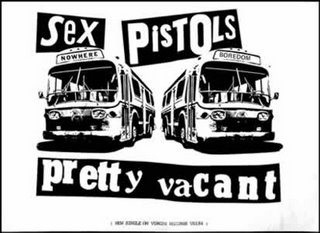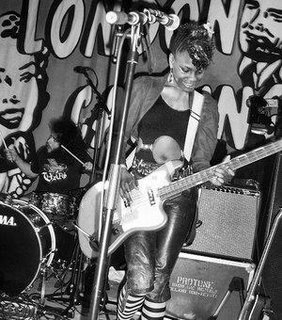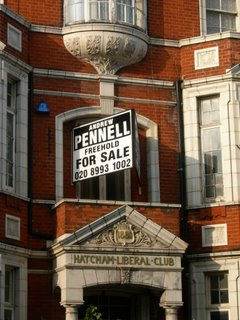Slightly Lost is the latest in a long line of people queuing up to slag off Croydon as 'a soulless, concrete homage to pure capitalism'. In fact one time Croydonites Kirsty McColl and David Bowie are quoted expressing similarly wrathful sentiments about their one time home.
I would be the last one to argue with this, Croydon is exactly as Slightly Lost describes it. One of the few redeeming feature of the town centre is the famous second hand record shop
Beanos, and even that it threatened with closure. And if Croydon is dull for many of us, let’s not forget that for some it is a real hell-hole as the home of the notorious Lunar House immigration office. As a
recent enquiry highlighted, this is a place where asylum seekers and other migrants face at best a bureaucratic nightmare and at worst detention and deportation.
Jamie Reid, most famous for Sex Pistols art work, was previously involved in a Croydon-based anarcho/situationist printing press The Suburban Press (based at 9 Sidney Road, SE25). An early edition of their zine includes a picture of Croydon town centre and the caption 'Lo! A Monster is Born - Croydon redevelopment 1956-1972 (see cover
here).
 A Jamie Reid design - Destination Boredom & Nowhere = Bromley & Croydon?
A Jamie Reid design - Destination Boredom & Nowhere = Bromley & Croydon?One of the best dissections of South London suburban life is Hanif Kureishi’s novel, 'The Buddha of Suburbia' (1990), a depiction of coming of age in the 1970s by the Bromley-raised author. The narrator, Karim Amir, is 'from the South London suburbs and going somewhere'. Amir/Kureishi is scathing about where he lives: ‘a dreary suburb of London of which it was said that when people drowned they saw not their lives but their double-glazing flashing before them’. And, again: ‘In the suburbs people rarely dreamed of happiness. It was all familiarity and endurance: security and safety were the reward of dullness'. In the suburbs he does find some sub-cultural oases – at one point he goes to see Kevin Ayers at the Three Tuns in Beckenham where 'my friends that I loved were standing at the bar, having spent hours in their bedrooms preparing for the evening, their gladdest moment being when a pair of knowing eyes passed over their threads'. But ultimately he has to go further into London and indeed New York to find the excitement he craves.
Still, Michael Bracewell also makes a good point in 'England is Mine: Pop Life in Albion from Wilde to Goldie' (Harper Collins, 1997): 'That the suburbs, as opposed to the city, have been the prime incubator and kindergarten for principal players in English popular culture is as certain as the equally strong role of the provinces. Around the extreme south-east of London, along the Bromley, Croydon and Sutton belt (a suburban curve, linking the urbanity of Lewisham and New Cross to the quasi-ruralism of Epsom and Leatherhead), the suburbs would become famous as a launch-pad for punk rock’.
Croydon has certainly giving birth to plenty of music over the years. As well as Kirsty McColl and David Bowie (the latter actually born in Brixton), Croydon was the birth place of Ralph McTell, writer of the 'Streets of London' – recently designated as the
no.1 London song by Time Out. The no.2 song on their list,
Waterloo Sunset, was also apparently partly inspired by Ray Davies's journeys to Croydon Art School. Several members of The Damned came from Croydon (see
previous post), and Bob Stanley and Pete Wiggs of
Saint Etienne also hail from there. One of my favourite songs of all time, Saint Etienne’s
Hobart Paving takes its name from a
Croydon-based company. Let's not forget the Purley Queen herself, Kate Moss – more of a muse than a musician, though she did contribute vocals to Primal Scream’s excellent version of Some Velvet Morning.
So is there something about the comfortable dreariness of places like Croydon that inspires people to leave and create something better? For Amir/Kureishi 'our suburbs were a leaving place, the start of a life' leaving him 'looking for trouble, any kind of movement, action and sexual interest'. If this restlessness is one source of creativity, there might also be a more prosaic reason for the suburbs’ contribution to the culture industry, namely that they are full of middle class kids with the cultural capital (education, equipment, confidence, connections) to make it in music and publishing.
Either way, 'So fuckin' Croydon' (a phrase coined by Bowie) remains apposite.
For a different take, see Weird Croydon or even
Strange Croydon.



.jpg) SHOT BY BOTH SIDES
SHOT BY BOTH SIDES




















